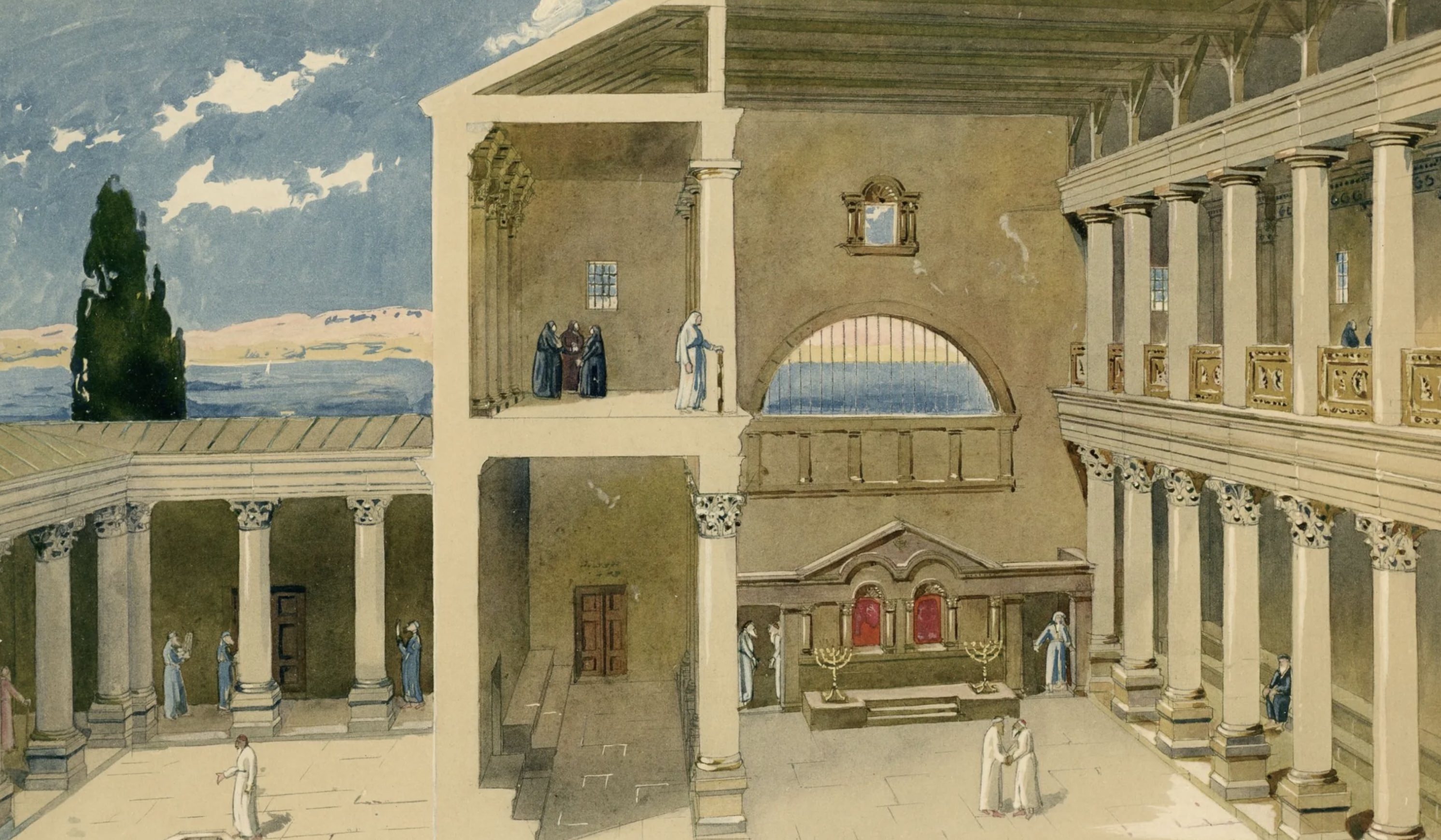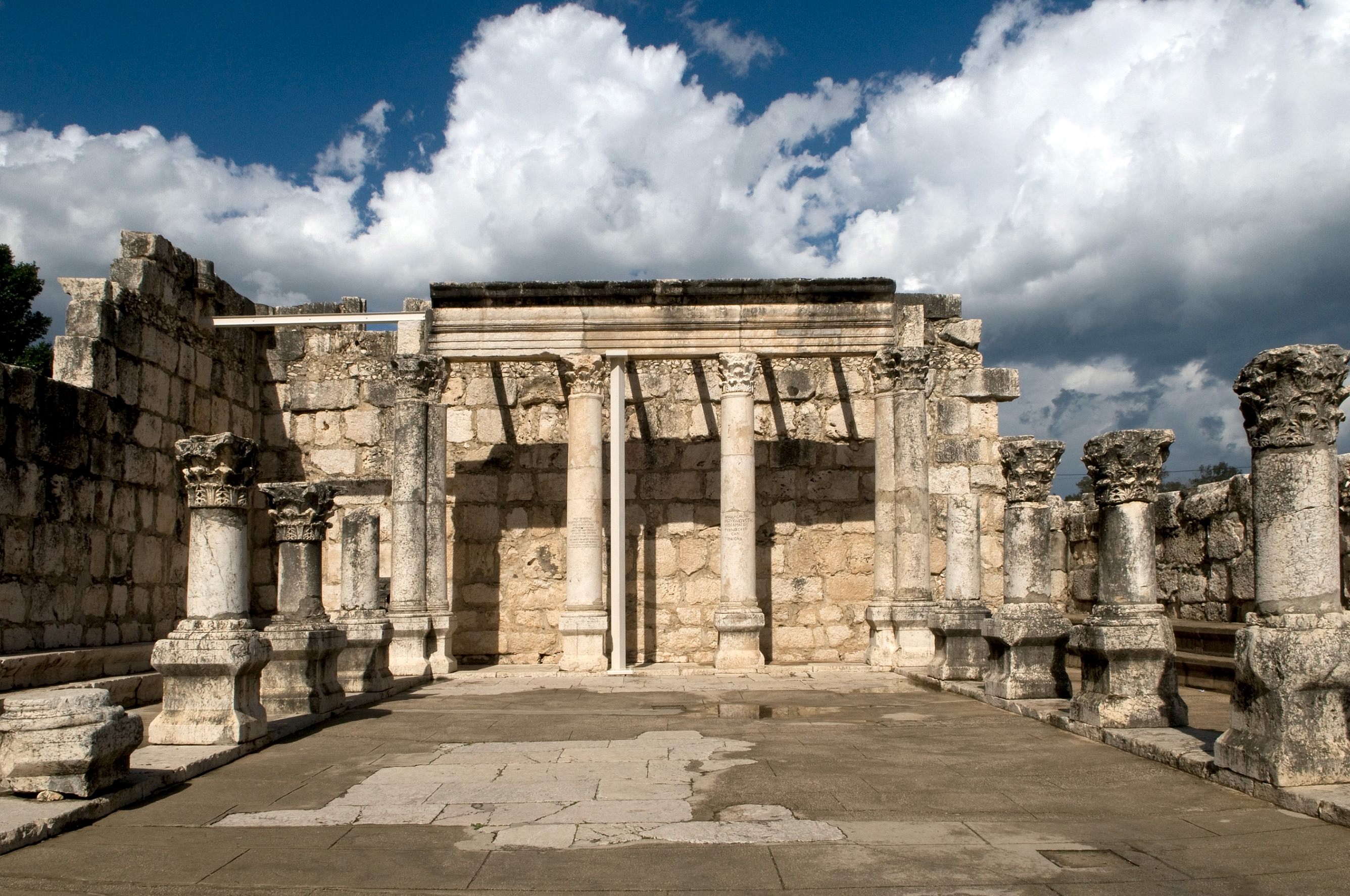The Origins of the Synagogue
The great Jewish Rabbi, Hillel, taught, "An ignorant man cannot truly be pious." For centuries, the Jewish people have been taught about their heritage, their God and have reaffirmed their sense of community in the "synagogues." This is the term we use to designate the meeting place for the Jews, and this is in fact what the word means in Greek, "gathering" or "assembly." This term, however, would have been puzzling to the ancient Hebrews since the synagogue, as we know it today, was not familiar to them. This article will examine the origins of the modern synagogue and note the developments that ultimately forged this ancient Jewish entity.
Old Testament
A. Patriarchs
Before Moses, the people with whom God had made a covenant had a semi-nomadic lifestyle and a religion that matched it. The camp and families were ruled by the patriarch who served as chief and priest for those within his family. The encounters with God were dynamic but few and far between. Noah, Abraham, Isaac, Jacob, Joseph, all served God as intermediaries between God and the covenant seed in various ways but none of these organized any systematic method of worship and instruction. A general meeting place was not part of the style of life or worship since the principal mode of worship was the sacrifice and for this purpose altars were built. During this period, we see all of these men building altars in various locals in order to worship God but no public meeting places were used. This is not to say that temples and elaborate worship houses did not exist (the tower of Babel) but they were not ordained for use by those with whom God had made His covenant.
B. Moses
With the exodus from Egypt led by Moses, we see the institution of the first organized system of worship authorized by God for His chosen people. It is here that we see the roots of what later becomes the synagogue.
While Moses was at Mt. Sinai, he is instructed to erect a Tabernacle, furnish it and give instructions as to its operation. The word for this in Hebrew is MISHKAN which means "dwelling place."
For centuries, God had visited His people through individuals. Now, however, He was establishing the idea that His presence could be among His people and not limited to a special appearance to selected ones.
During this period, the MISHKAN did not serve as an auditorium for the gathering of people but rather as a housing for sacred objects (tablets of the Law, Holy Ark, eternal lamp, etc.) with which the chosen priests ministered to God on behalf of the people. The people gathered at the "tent of meeting," not in the tent of meeting. Once the people entered the promised land (Palestine), they began to settle it by conquering the nations there. At this time, their elements of worship were still portable (Holy Ark and its contents).
C. Solomon
King David symbolizes the height of military and youthful energy of the Jewish nation. A faithful man with a clear vision, he knew that only faith in God guaranteed victory not only in personal life but also in the national affairs of the people. His military victories were to him the steppingstones in accomplishing the great objective for which he felt called...the building of a house for God (I Kings 5:1-6). Again, the idea was similar (but more grandiose) to the "tent of meeting" wherein the sacred objects and priesthood would be located. A new dimension was added and that was that now a permanent place for God would be situated in the city where the permanent place for the king was established. God's house would be next to the king's house, thus making Jerusalem a significant city for the Jews. Solomon, David's son, accomplished this magnificent building enterprise by building the first temple, as well as a kingly palace.
As a result of this activity, Jerusalem became the center for religious activity for Jews throughout Palestine. They came for the feasts, to sacrifice, to hear the instructions from the Law (which were so necessary since they easily wandered into idolatry).
Origins of the Synagogue
There is much debate as to the origin of the synagogue as a meeting place with a set standard of religious exercises. The two views have as a key date 587 B.C. One group says that the synagogue began only after this date,
Its origin is unknown, but it may reasonably be surmised that it had its antecedents in spontaneous gatherings of Jews in Babylonia and other lands of their exile on the sabbaths and at the times of the old seasonal feasts or on fast days, to confirm one another in fidelity to their religion in the midst of heathenism, and encourage themselves in the whole of restoration.
The main opposing opinion situates the origin of the synagogue near the end of Solomon's reign. (There is also a body of opinion who quotes Philo and Josephus' claims that the synagogue goes back to Moses; this group, however, is small).
The main argument for the 800-900 B.C. date (Solomon) gives several reasons to support their case:
- The need and ability of people to express their religious feelings could not be satisfied with only a few pilgrimages a year to Solomon's temple. The desire to exercise their religious beliefs found outlets in common prayer, readings at local gatherings.
- Many periods of political and religious corruption in Jerusalem forced the Levites to "go" to the people and instruct them. Religious reform was carried to the people in this way (II Chronicles 17:9).
- Several Scriptures suggest that some form of meeting place existed for the purpose of prayer, the reading of the Law, teaching and fellowship (Jeremiah 39:8; Psalms 74:7-8).
The scholars who hold this view present a picture of a nation with a central place for sacrifice and worship but because of practicality and human need, the collecting of people in local villages for the purpose of "sharing their faith" slowly develops. This fellowship of believers, then, begins to meet in a more organized way and with time is found to be a pattern of lifestyle for the normal Jewish family.
I tend to agree with this theory (even though there is no archeological or historical evidence yet) since this is the way that people react and evolve in every society with regards to religious life and practice.
The Synagogue is Born
A. Babylon
There may be a difference of opinion as to the existence of formal meeting places for prayer and study in Palestine before 587 B.C. Some say actual buildings served this purpose, others claim that informal gatherings at the homes of the prophets or Levites were the extent of any forms of worship away from the temple in Jerusalem. Opinions converge, however, when we reach the year 587 B.C.
During this period, the Southern kingdom is destroyed (the temple and city) and the people are carried off to Babylon. With the disappearance of the temple, the Jews in exile are deprived of the focal point of their religious life. Into this vacuum enters Ezekiel and his ministry to the exiles in the land of Babylon. Eisenberg writes in his history of the synagogue,
It may be, as scholars have suggested, that the visits to the home of Ezekiel were a continuation of the visits Israelites had made to the "man of God" on special days, as in the time of the prophets Samuel and Elisha. Be that as it may, tradition has it that the first synagogue ever built for the purpose of prayer was in Babylonia. According to Jewish legend, it was located in Nehardea, the first distinguished seat of learning, and was constructed near the House of Study of Ezra with the stones and the earth that had been transported from the Temple at Jerusalem - a sign of continuity.
What had only been practiced and organized loosely for convenience sake now became the new norm for religious activity. The synagogue with prescribed religious exercises, traditions and locations are now at the center of the Jewish spiritual experience. The synagogue is born among the ruins of a dispersed nation in a foreign land. It does not replace the Temple or even serve as substitute but rather comes to the fore as a creation born of need based on what is available materialistically and permissible spiritually. And so, the Jews retain a sense of nationhood, religion and hope as they gather at the MIKDASH MEAHT or little sanctuary (Ezekiel 11:16).
B. Jerusalem
In 538 B.C., the beginning of the repopulation of the city and countryside around Jerusalem began. As the Jews were returning from exile, the foremost objective was to rebuild the Temple. Under the leadership of Ezra and Nehemiah much of this was accomplished.
Physically, the Temple was rebuilt and much of the former activity was reinstated but now an additional activity was given much attention, the reading and study of the Law. This study had its major champion in the prophet Ezra. Much like the great translators of the Middle Ages, Ezra served as the man who brought the word of God to the common people.
The common Jew, because of his experience in Babylon, became a student of the Law, offered prayers in common assembly, openly taught his peers (this had previously been the strict domain of the priests and Levites) and continued this religious activity even after the return from Babylon and the rebuilding of the Temple. One by one synagogues for this purpose were erected throughout the land, not in competition with the Temple, but as an extension of it. This form continued until Christ and beyond the destruction of the second temple in 70 A.D. It is very much with us today and in fact is the center for religious life for Jews all over the world.
Summary
There are many theories as to the definite origins of the synagogue. Some claim its beginnings with Moses, others see it developing around the period of Solomon's temple, the majority claim its emergence during the Babylonian captivity. The most probable conclusion is that its roots are in the natural disposition of the Jewish people to gather together and express their religious convictions as a corporate unit. Whether it began as a few of the elders gathering for prayer in the period of Moses' wilderness wanderings; or a community sitting at the feet of Elijah the prophet gaining instruction and a blessing; or the banished people of the captivity clinging to one another in the face of great sorrow; or even the building of a house of prayer in Palestine in the 4th century; one thing is sure, the spirit that the synagogue represents has always been present within the Jewish nation.
Synagogue Building
Most synagogues in the early periods were built in a similar fashion. They were built of stone and laid North and South with the entrance at the South end. Their elegance depended on the financial strength of the members. They were furnished with the following items:
- A chest in which the scrolls of Scripture were kept, wrapped in a linen cloth.
- A platform or elevated place with a reading desk.
- Various objects used in worship were also present: lamps, candelabra, trombones, trumpets and benches for the worshippers.

Artist's rendition of the building.

Ruins of the Synagogue at Capernaum partially restored. The site is probably the same as where Jesus taught, although the ruins of this limestone building are of a later date.


